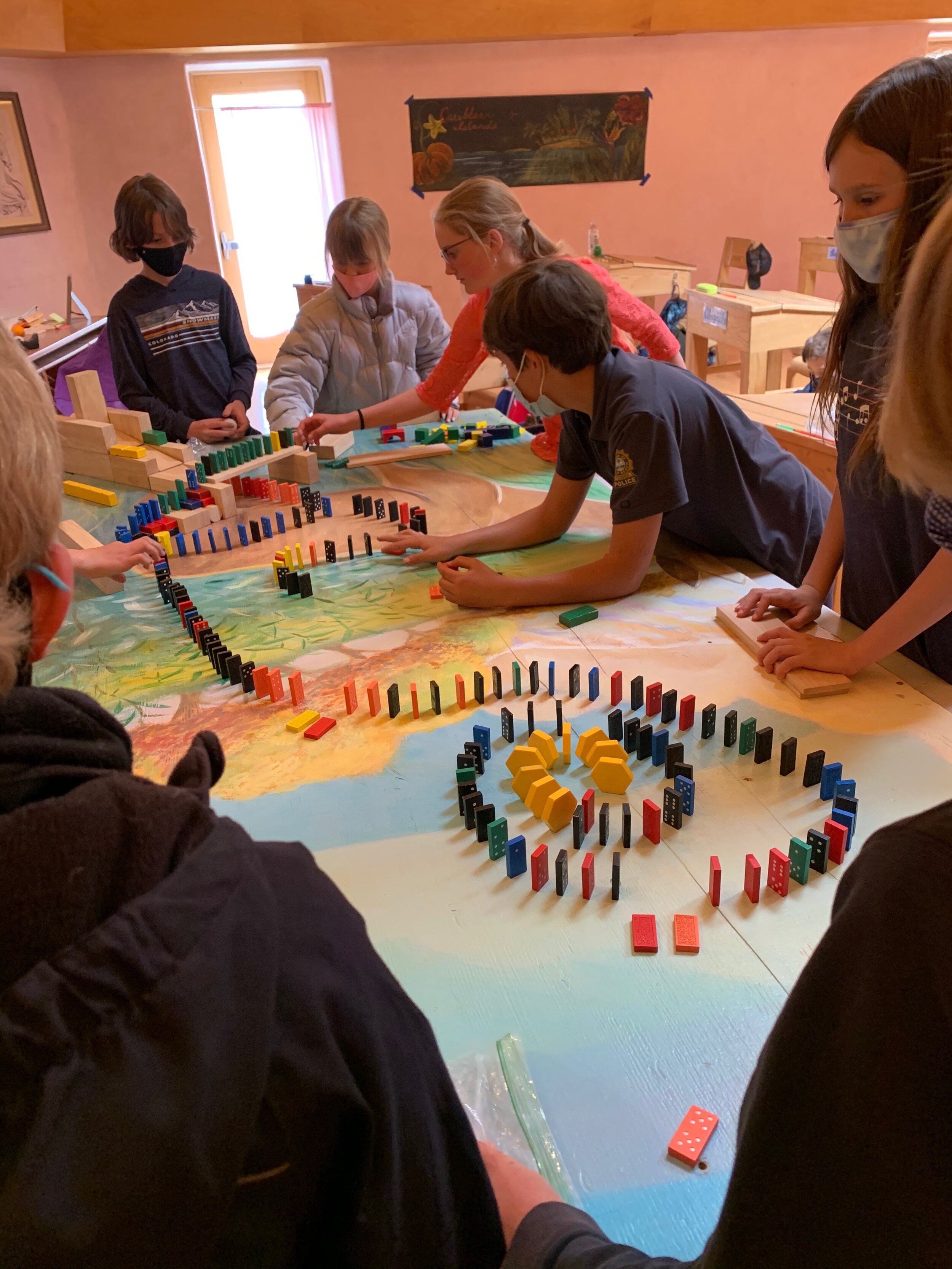Preparing our students to engage with and impact the world around them is a primary goal of Waldorf Education.
~ ~ ~
With this in mind, preparing our students for responsible, healthy technology engagement is a critical curriculum component in order to prepare students to navigate the world.
In Waldorf Education, we nurture critical thinking, creativity and adaptability in our students. We believe the foundation for these capacities is best laid in an early childhood and grades 1-5 curriculum, free of technology in our classrooms. Instead we focus on honing the students’ skills with pencil and paper.
Because we understand and believe technology and media are prevalent and important forces in the world today, we introduce our three-year Cyber Civics program in 6th grade. Students begin working with technology as a tool, while learning to question and navigate ethical, responsible technology use and media engagement .
From our early childhood program on, we work closely with families to foster a thoughtful, healthy approach to media and technology. Ideally, teachers and families work cohesively to nurture students and prepare them for a balanced, lifelong relationship with the many dynamic components of technology and media in the world today. From healthy habits to groundbreaking innovations.
Are you wondering if this puts our alumni at a disadvantage? We have found that our alumni are capable of working on the cutting edge of innovation by applying their capacities for critical thinking and problem solving to the endless possibilities technology affords us. They are just as likely to hold roles in leading technology companies as in any other field. What’s more, they openly expressed gratitude for their slow tech introductions and see direct positive impacts on their lives. Explore more perspectives from our alumni here!
Continue reading for more details on our Slow Tech Media Diet approach…
Media & Technology Commitments
At the Waldorf School on the Roaring Fork:
We use a ‘Slow Tech’ not a ‘No Tech’ approach
We make an important distinction between active and passive media consumption
We ask all of our families to read the below information carefully for a detailed look at a ‘slow’ tech approach and distinctions between active and passive technology
We ask our families to take time to consider their individual exposure levels according to the age of their children (including across siblings)
We ask our families to invest in a media approach that empowers their student(s) to thrive in and out of our classrooms when it comes to their capacities to connect, engage and consider
We are committed to not only working with families to navigate the complicated world of media and technology but continue our unwavering mission to prepare our students for global citizenship, in every aspect of the term. Like technology, we are constantly evolving and adapting.
What Is A ‘Slow Tech’ Approach?
WSRF faculty member Patti Connolly in partnership with Diana Graber (founder of CyberWise) have carefully considered and developed a framework for a Slow Tech Media Diet, taking into perspective children in today’s world and their developmental points. This outline provides structure and guidance for media and technology use and exposure as it applies to children spanning ages newborn to 14 years. These guidelines stand as our recommendations for consideration when adjusting media and technology exposure levels and engagement to meet your child’s developmental phase.
An outline is provided below in both grid, image form as well as a bullet point form. Additional resources have also been provided and we welcome any questions or further discussion of our media and technology approach at The Waldorf School on the Roaring Fork. This outline and information is the work and articulations of Patti Connolly and Diana Graber. Please do not reproduce without permission.
We look forward to working closely with your family to nurture engaged, thoughtful individuals with capacities for critical thinking, problem solving and innovation.
Looking for More Resources?
How I Got My Students to Stop Starting at Screens, Time Magazine (here)
The Big Disconnect, Catherine Steiner-Adair (here)
Slow Tech Parenting ideas from Janell Burley Hoffman (here)
Christakis, Dimitri A. "Interactive media use at younger than the age of 2 years: time to rethink the American Academy of Pediatrics guideline?" JAMA pediatrics 168.5 (2014): 399-400. (here)
Technology and Digital Literacy in the Early Years, Chip Donahue (co-published by NAEYC and Routledge). (here)
“A child’s brain develops rapidly...children learn best by interacting with people, not screens.”
Slow Tech Media Diet for Children
Developed by Patti Connolly and Diana Graber, founder of cyberwise.org
0-2 year olds need:
To explore, learn to trust, and engage in “joint attention” with you.
No passive screen time – TV, DVDs, tablets, smartphone viewing.
Her parent(s) to put away computers and tablets when with her.
An introduction to how to participate with tech devices in a very limited, positive way by engaging in these activities with you, such as: Face Time or Skype with grandparents or extended family.
3-6 year olds need:
Uninterrupted time engaged in unstructured old-fashioned play (dress up, active outside play, creative, rough and tumble), playing with toys that require a “stick-to-it kind of attention”, exploring nature, listening to you read and tell stories.
Active social participation with tech devices in a very limited, positive way by engaging with you. Continue to Face Time or Skype with grandparents or extended family. Add a few more practical, social activities such as: your child dictating an email to extended family as she sits next you as you type or learning from or playing with age-appropriate, parent-reviewed apps with you. Maximum active media participation=5 minutes a day.
Strict limits on her passive screen time of age-appropriate programs – either none or with you co-viewing on Friday night-Saturday night, maximum viewing time per day = 1 hour total.
7-9 year olds need:
Uninterrupted time to play with other children and with open-ended, creative toys, to be actively engaged in real life experiences, to read and be read to, to pursue hobbies, to explore nature.
Co-participating with media through tech devices with you. See above for ideas. Add co-creating media (videos, music, stories, etc.) and co-viewing media that help your child learn how to make something new (like sing a new song).
An introduction to independently participating in media, such as: using interactive age-appropriate apps and playing creative, interactive, non-violent video games.
Maximum active media participation (co-participation and independent participation)=15-30 minutes a day.
Limited passive screen time with you co-viewing on Friday night-Saturday night, maximum viewing time per day=1 hour total.
Your firm guidance on how to move through boredom or feelings of peer pressure without engaging in screen time.
10-12 year olds need:
Uninterrupted time to play with others with open-ended, creative play materials, to be actively engaged in real life experiences, to read, to pursue hobbies, to explore nature.
Co-participating with media through tech devices with you. See suggested activities for 6-9 year olds. Add sometimes researching a question child has online with you, beginning to learn how to keyboard and how to program, and setting up an email account that you monitor and control the password for.
Independent participation with media. See suggested activities for 6-9 year olds and add creating media (videos, music, stories, etc.) with parent supervision, reading e-books, writing family and friends occasional emails.
Maximum active media participation=30-45 minutes a day.
Limited passive screen time with you co-viewing Friday night-Saturday night, maximum viewing time per day = 1 hour total.
Your firm guidance on how to move through boredom or feelings of peer pressure without engaging in screen time.
13-14 year olds need:
Time to engage in nature in new, challenging ways (rock climbing, mountain biking, etc.), to pursue hands on interests/hobbies, and to spend time being with friends in active, “real life” experiences.
Independent participation with media. See above suggestions. Add researching online for school or for own interests with parent support, completing homework on computer in common area of house, viewing media that helps her learn how to make something new, possibly having own cell phone to communicate with others. Maximum active media participation=60 minutes a day.
Clear agreements with you about tech use tailored to her age. It’s more about how she uses technology instead of how much she uses it.
To create code of conduct with you. Here is one from Janell Burley Hofmann: “Don’t be mean, don’t lie, don’t embarrass other people, don’t pretend to be someone you’re not, don’t go places you’re not allowed to go. Don’t post pictures that Grandma wouldn’t love.”
Limited passive screen time on weekends only.
Your firm guidance on how to move through boredom or feelings of peer pressure without engaging in screen time.
The Slow Tech Media Diet in both grid and bullet point form is the intellectual property and creation of Patti Connolly and Diana Garber. Please do not reproduce without permission.








